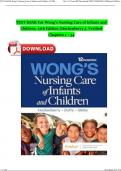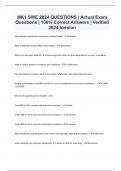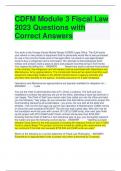TEST BANK Wong's Nursing Care of Infants and Children (12TH) ... file:///C:/Users/HP/Downloads/TEST%20BANK%20Wong's%20Nur...
TEST BANK For Wong's Nursing Care of Infants and
Children, 12th Edition (Hockenberry,), Verified
Chapters 1 – 34
1 of 408 9/11/2024, 5:06 AM
,TEST BANK Wong's Nursing Care of Infants and Children (12TH) ... file:///C:/Users/HP/Downloads/TEST%20BANK%20Wong's%20Nur...
Chapter 01: Perspectives of Pediatric Nursing
Multiple Choices
1. What is the major cause of death for children in the United States?
a. Heart disease
b. Childhood cancer
c. Injuries
d. Congenital anomalies
ANS: C
Unintentional injuries (accidents) are the leading cause of death after age 1 year through adolescence. The
leading cause of death for those younger than 1 year is congenital anomalies, and childhood cancers and
heart disease cause a significantly lower percentage of deaths in children older than 1 yearof age.
DIF: Cognitive Level: Understanding TOP: Nursing Process: Planning
MSC: Client Needs: Health Promotion and Maintenance
2. Parents of a hospitalized toddler ask the nurse, “What is meant by family-centered care?” The nurse
should respond with which statement?
a. Family-centered care reduces the effect of cultural diversity on the family.
b. Family-centered care encourages family dependence on the health care system.
c. Family-centered care recognizes that the family is the constant in a child’s life.
d. Family-centered care avoids expecting families to be part of the decision-making
process.
ANS: C
The three key components of family-centered care are respect, collaboration, and support. Family- centered
care recognizes the family as the constant in the child’s life. The family should be enabled and empowered
to work with the health care system and is expected to be part of the decision-makingprocess. The nurse
should also support the family’s cultural diversity, not reduce its effect.
DIF: Cognitive Level: Applying TOP: Nursing Process: Implementation
MSC: Client Needs: Health Promotion and Maintenance
3. Evidence-based practice (EBP), a decision-making model, is best described as which?
a. Using information in textbooks to guide care
b. Combining knowledge with clinical experience and intuition
c. Using a professional code of ethics as a means for decision making
d. Gathering all evidence that applies to the child’s health and family situation
ANS: B
EBP helps focus on measurable outcomes; the use of demonstrated, effective interventions; and questioning
the best approach. EBP involves decision making based on the integration of the bestresearch evidence
combined with clinical expertise and patient values.
DIF: Cognitive Level: Remembering TOP: Nursing Process: Planning
MSC: Client Needs: Safe and Effective Care Environment
4. The nurse is talking to a group of parents of school-age children at an after-school program about
childhood health problems. Which statement should the nurse include in the teaching?
a. Childhood obesity is the most common nutritional problem among children.
2 of 408 9/11/2024, 5:06 AM
,TEST BANK Wong's Nursing Care of Infants and Children (12TH) ... file:///C:/Users/HP/Downloads/TEST%20BANK%20Wong's%20Nur...
b. Immunization rates are the same among children of different races and ethnicity.
c. Dental caries is not a problem commonly seen in children since the introduction of
fluorinated water.
d. Mental health problems are typically not seen in school-age children but may be
diagnosed in adolescents.
ANS: A
When teaching parents of school-age children about childhood health problems, the nurse should include
information about childhood obesity because it is the most common problem among children and is
associated with type 2 diabetes. Teaching parents about ways to prevent obesity is important toinclude.
Immunization rates differ depending on the child’s race and ethnicity; dental caries continuesto be a
common chronic disease in childhood; and mental health problems are seen in children as young as school
age, not just in adolescents.
DIF: Cognitive Level: Applying TOP: Integrated Process: Teaching/Learning
MSC: Client Needs: Health Promotion and Maintenance
5. The nurse is planning care for a hospitalized preschool-aged child. Which should the nurse plan to
ensure atraumatic care?
a. Limit explanation of procedures because the child is preschool aged.
b. Ask that all family members leave the room when performing procedures.
c. Allow the child to choose the type of juice to drink with the administration of oral
medications.
d. Explain that EMLA cream cannot be used for the morning lab draw because thereis not
time for it to be effective.
ANS: C
The overriding goal in providing atraumatic care is first, do no harm. Allowing the child, a choice ofjuice
to drink when taking oral medications provides the child with a sense of control. The preschoolchild
should be prepared before procedures, so limiting explanations of procedures would increase anxiety. The
family should be allowed to stay with the child during procedures, minimizing stress.
Lidocaine/prilocaine (EMLA) cream is a topical local anesthetic. The nurse should plan to use theprescribed
cream in time for morning laboratory draws to minimize pain.
DIF: Cognitive Level: Applying TOP: Nursing Process: Planning
MSC: Client Needs: Health Promotion and Maintenance
6. Which situation denotes a nontherapeutic nurse–patient–family relationship?
a. The nurse is planning to read a favorite fairy tale to a patient.
b. During shift report, the nurse is criticizing parents for not visiting their child.
c. The nurse is discussing with a fellow nurse the emotional draw to a certain patient.
d. The nurse is working with a family to find ways to decrease the family’sdependence on
health care providers.
3 of 408 9/11/2024, 5:06 AM
,TEST BANK Wong's Nursing Care of Infants and Children (12TH) ... file:///C:/Users/HP/Downloads/TEST%20BANK%20Wong's%20Nur...
ANS: B
Criticizing parents for not visiting in shift report is nontherapeutic and shows an under involvement with
the parents. Reading a fairy tale is a therapeutic and age-appropriate action. Discussing feelingsof an
emotional draw with a fellow nurse is therapeutic and shows a willingness to understand feelings. Working
with parents to decrease dependence on health care providers is therapeutic and helps to empower the
family.
DIF: Cognitive Level: Analyzing TOP: Integrated Process: Caring
MSC: Client Needs: Psychosocial Integrity
7. The nurse is aware that which age-group is at risk for childhood injury because of the cognitive
characteristic of magical and egocentric thinking?
a. Preschool
b. Young school age
c. Middle school age
d. Adolescent
ANS: A
Preschool children have the cognitive characteristic of magical and egocentric thinking, meaning they are
unable to comprehend danger to self or others. Young and middle school-aged children have transitional
cognitive processes, and they may attempt dangerous acts without detailed planning but recognize danger to
themselves or others. Adolescents have formal operational cognitive processes andare preoccupied with
abstract thinking.
DIF: Cognitive Level: Understanding TOP: Nursing Process: Assessment
MSC: Client Needs: Safe and Effective Care Environment
8. The school nurse is assessing children for risk factors related to childhood injuries. Which child hasthe
most risk factors related to childhood injury?
a. Female, multiple siblings, stable home life
b. Male, high activity level, stressful home life
c. Male, even tempered, history of previous injuries
d. Female, reacts negatively to new situations, no serious previous injuries
ANS: B
Boys have a preponderance for injuries over girls because of a difference in behavioral characteristics, a high
activity temperament is associated with risk-taking behaviors, and stress predisposes children toincreased
risk taking and self-destructive behaviors. Therefore, a male child with a high activity level and living in a
stressful environment has the highest number of risk factors. A girl with several siblingsand a stable home
life is low risk. A boy with previous injuries has two risk factors, but an even temperis not a risk factor for
injuries. A girl who reacts negatively to new situations but has no previous serious illnesses has only one risk
factor.
DIF: Cognitive Level: Analyzing TOP: Nursing Process: Assessment
MSC: Client Needs: Safe and Effective Care Environment
9. An adolescent patient wants to make decisions about treatment options, along with his parents. Which
moral value is the nurse displaying when supporting the adolescent to make decisions?
4 of 408
9/11/2024, 5:06 AM






